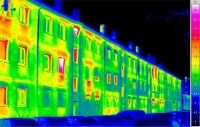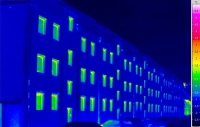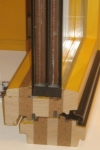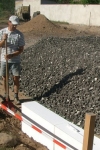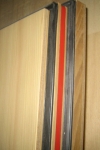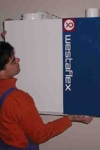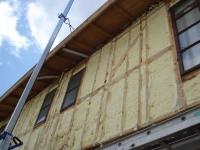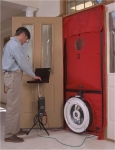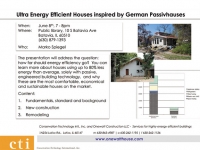Most scientists, supported by concrete data, agree that the earth is heating up. Over the last ten years the average temperature has climbed about 1 degree Fahrenheit around the globe. And, even if you choose to reject science and the assessment that global temperatures and sea levels are rising, it would be difficult to ignore the economic recession. Rising gas prices compound the economic crisis caused by the mortgage meltdown and rising unemployment numbers
So, what do we do about it?
Do we all put solar panels on our roofs? Is it enough to replace our light bulbs with compact florescent light bulbs (CFLs)? Do we have what it takes to start carpooling to work, turning the thermostat down in the winter and up in the summer? I started asking myself all of these questions after being laid off from my last job as a carpenter at the LaSalle Nuclear Power Station (a touch of irony) in January of 2009.
Initially I came to the conclusion that we should focus our efforts on conserving energy or producing energy from non-carbon emitting sources like windmills or solar panels. It turns out that solar panels are actually a poor return on investment and wind only makes sense in rural areas. Nuclear invites controversy while we try to develop a better way of disposing of nuclear waste.
Then I remembered a fellow I ran into on the campaign trail who had focused his business, Conservation Technologies International (CTI) on developing ultra-efficient green building technology used in Germany. The Germans have figured out how to conserve up to 80% of the energy used in a home or commercial building while Americans are just starting to scratch our heads and ask, “what is a green collar job?” I know. It has a similarly sad storyline as the GM vs. Prius crisis unfolding in Detroit. These ultra-efficient buildings are called “passive houses” and it has evolved into a full-blown movement in Germany, Austria and most European countries.
What is passive building?
Pioneered by the Passive House Institute in Darmstadt, Germany, passive buildings reduce energy consumption by up to 80% without the use of renewables or conventional heating systems. Achieving these efficiency levels requires advanced building technology that includes super insulation, super windows, super doors and special low
load HVAC systems. Over 10,000 buildings of all types have been built/retrofitted in Germany and Austria. The technology is proven, convincing and will be adopted as the de-facto building standard of Germany within the next ten years. In Illinois, four passive homes have been constructed, two in Urbana and two the western Chicago suburbs.Why is passive building technology more stimulating to the economy than building a road or bridge?
There are several components essential to passive building that are not currently produced in the United States. If Illinois embraces passive building first, businesses that produce highly efficient windows, doors, HVAC equipment and insulated foundation rocks will all originate in Illinois.
Additionally, passive building retrofits would create jobs in the technology sector, as Illinois would need several hundred energy raters, more engineers and more architects. German studies show that investing $1 million in passive building creates sixteen man years of job opportunities, most jobs in the building trades.
What about green roofs and efforts embraced by USGBC?
I think that US Green Building Council (USGBC) has good intentions and will eventually turn their focus towards energy efficiency, but until then, governmental efforts and individual efforts should concentrate on energy efficiency. USGBC pushes LEED certification that addresses a number of criteria in their expensive certification process. It would be more beneficial for governmental institutions to focus on ASHRAE’s certification process that hones in on energy efficiency. Our neighbors to the north in Wisconsin have developed an Energy Star-Wisconsin home building program that certifies energy efficient homes.The program is in its eighth year and Illinois has yet to pass a statewide residential building code.
At the federal level, it is clear that President Obama’s Secretary of Energy, Steven Chu understands the importance of focusing on energy conservation. On May 26, Chu hinted at an initiative to paint the rooftops of all federal buildings with a reflective white paint. This is a small step, but a step in the right direction.
Maybe more importantly is the question of, “what should Illinois be doing?”
First, I would like to suggest that everyone attend Marko’s next presentation. Admission is free and this event is sponsored by the Fox Valley Sierra Club.
Ultra Energy Efficient Houses
inspired by German PassivhausesWhen: June 8, 7-8:30 p.m.
Where: Batavia Public Library (10 S. Batavia Ave., Batavia, IL)
Many people will walk away from this presentation and say, “that was really cool. Maybe I should do something like that.” The challenge as usual is the upfront costs (paid off over time, but still upfront) associated with ultra-efficient buildings. This is where political leaders need to step up and lead. Consider that Obama’s stimulus plan featured over $40 billion for green building retrofits/alternative that got everyone scratching their heads and talking about green collar jobs, but we need more.
So what specific steps should Illinois take to establish a national leadership role in green building?
- Illinois should retrofit several public buildings as “light-tower” projects around the state. These buildings will serve a duel purpose of displaying the technology to the community and saving taxpayers money.
- Illinois could easily attract businesses to our state that can produce necessary components. This effort is ongoing.
- Illinois should phase in a “building energy pass” which documents efficiency measures to achieve market feedback — a miles per gallon document for buildings, needed to build efficiency awareness.
- Illinois should fund legislation that rewards homeowners, business owners and municipalities who retrofit buildings to more energy efficient standards; ideally on a sliding scale (ultra-efficient homes would receive a bigger subsidy than moderately retrofitted buildings).
- Illinois should adopt more stringent building codes that apply to new construction in the residential and commercial markets. House Bill 3987 requires home builders to use wall and ceiling insulation, but green builders like CTI have proven that we can achieve much better than this.
- Illinois should mandate that state and municipal buildings employ a building manager who is a certified energy rater and building performance inspector.
- Illinois should develop our own research center that will serve as the epicenter for the nationwide passive movement. Consider that the Wisconsin Energy Center is miles ahead of anything happening in Illinois; including the Smart Energy Design Assistance Center (SEDAC).
The “should do” list could be much longer, but this is largely an introductory piece.
And even though Illinois is the seventh largest producer of greenhouse gasses in the United States, things here move sloooowly. Maybe things would move faster and gain focus if Illinois lawmakers had to deal with famine in Africa, hurricanes in Louisiana and rising ocean levels in Australia.
Tags: Conservation Technology International, CTI, energy efficiency, environment, global warming, green building, green collar job, Illinois General Assembly, John Laesch, Marko Spiegel, passive house, Sierra Club
